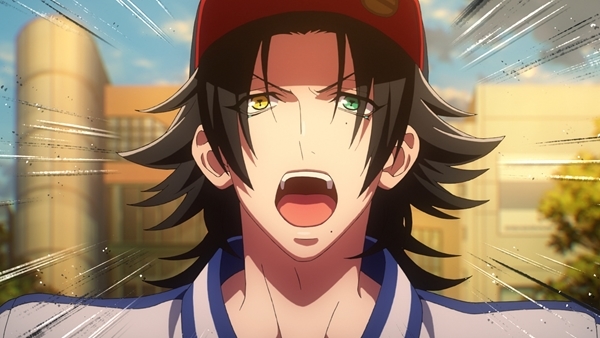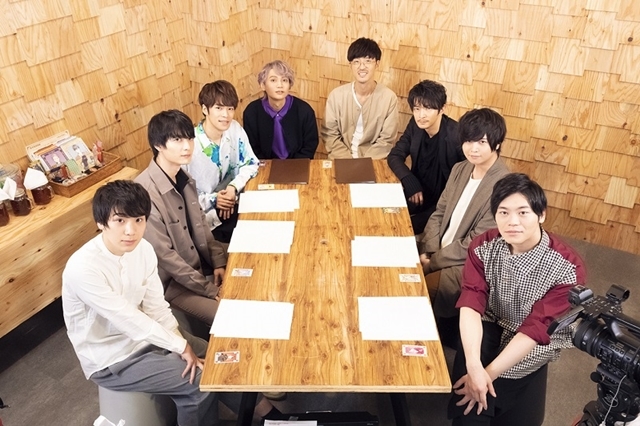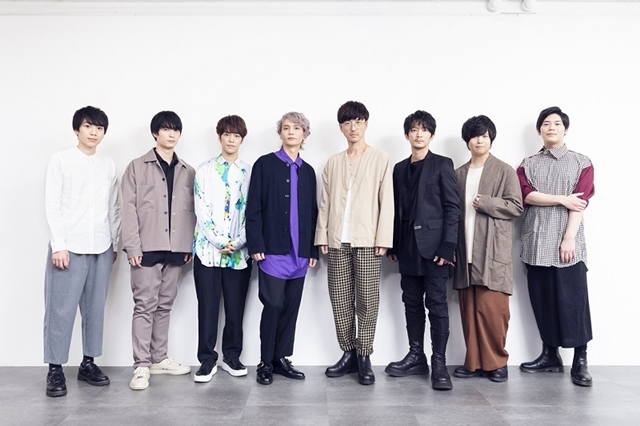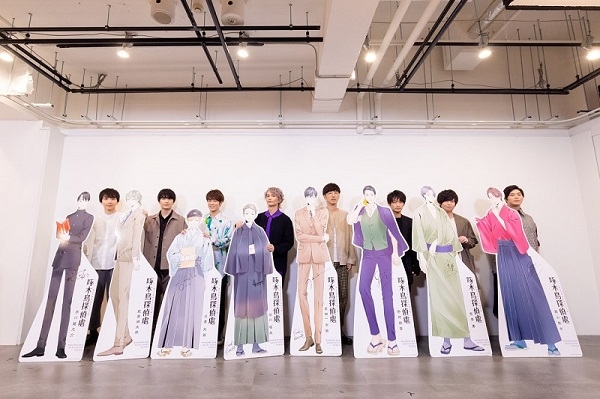Published: 2020/11/27
Original URL: https://news.mynavi.jp/article/20201127-1533653/
Features:
Ishiya Haruki (Yamada Jiro in Hypnosis Mic)
Komada Wataru (Iruma Jyuto in Hypnosis Mic)
Saito Soma (Yumeno Gentaro in Hypnosis Mic)
Kijima Ryuichi (Izanami Hifumi in Hypnosis Mic)
Mentioned:
Kimura Subaru (Yamada Ichiro in Hypnosis Mic)
Amasaki Kohei (Yamada Saburo in Hypnosis Mic)
Asanuma Shintaro (Aohitsugi Samatoki in Hypnosis Mic)
Kamio Shinichiro (Busujima Mason Rio in Hypnosis Mic)
Shirai Yusuke (Amemura Ramuda in Hypnosis Mic)
Nozuyama Yukihiro (Arisugawa Dice in Hypnosis Mic)
Hayami Show (Jinguji Jakurai in Hypnosis Mic)
Ito Kent (Kannonzaka Doppo in Hypnosis Mic)
—What were your impressions after watching Hypnosis Mic -Division Rap Battle- Rhyme Anima?
Ishiya: “They’re moving!” Having the characters animated meant that we could see their height differences, and seeing the city and the people living there expanded the world view. When I saw Ikebukuro Division in the anime, I thought, “This is the neighbourhood where the three brothers grew up.”
—What part of it made you think that?
Ishiya: The public order *laughs*. In Episode 2, Samezuka hears a cellphone ringing and says, “Whose is that?! Why isn’t your phone in silent mode?!” That line shows his goodness. Normally you would’ve expected him to say, “Whose is that?! Show yourself! I’ll beat you to death!”
Kijima: Seeing the other people in the neighbourhood makes it feel lived-in—it makes you feel closer to the world that the characters live in. In Shibuya Division, there’s another host, Uwabami, that talks a lot.
—I’m curious about how Uwabami and Hifumi would’ve interacted at work.
Kijima: The hosts probably fought amongst themselves too. I’d like to see a rap between hosts, although it seems like it’d be hard to make each of them unique.




Komada: Before the Hypmic mobile game came out, there weren’t many official illustrations. In the letters I received from fans, I could tell that the scarcity of official art gave them a lot of room for imagination. So when the anime adaptation happened, I thought, “Finally!”
Like Haru-kun (Ishiya) said, compared to the height numbers on the characters’ profiles, it’s easier to tell their height differences when they’re moving around on screen. Whether they’re glaring at each other eye-to-eye or one of them is looking down on the other is an important aspect. I think that the fans who have been supporting the franchise this whole time will discover a lot of things in the anime, some expected and some not.
—Did you make any discoveries, Komada-san?
Komada: From the numbers, I knew that Samatoki was a bit taller than Jyuto, but seeing them actually talking to each other, I thought, “So it really is like this.” I wasn’t satisfied with that feeling of being slightly looked down on, though. *laughs*
Saito: When I first watched Episode 1, I was impressed at how the rap battles showed coolness in various ways. They tried different presentations for each division and song, so I thought it’d be fun to rewatch the anime from different angles.




—The flashiness of the rap battles was well received.
Saito: Hypmic excels with the uniqueness of its setting and characters, so I think the Hypmic-ness permeates through the whole anime. Every episode has a lot of hooks that make me go, “Wait, can you hold on a sec?” and want to rewind 15 seconds. I think it’s a good match for the current era.
The character names that the cast shouted out were…
—Tell us your memorable scenes from the eight episodes that have aired so far.
Ishiya: At the beginning of Episode 1, when Jiro and Saburo come in. Ama-chan (Amasaki Kohei who plays Yamada Saburo) and I were talking about how happy we were that we got to say the first lines out of the 12 characters.
—Amasaki-san also said that he was happy about that.
Ishiya: Then in Episode 2, the scene where Ichiro is running to Jiro and Saburo. It was really badass and protagonist-like how he jumped over the wall behind them. There was a delinquent-ness to it too, like even though he was an ally, he had the coolness of an enemy.




Komada: Honestly, up until that scene I was thinking, “Ichiro, stop rapping and run faster,” but I forgave him when he arrived. He was cool.
Kijima: Something that was cool in Shinjuku Division was Jakurai-sensei’s narration at the beginning of Episode 3. “This is Shinjuku Division, where neon lights shine all night…” Hayami-san’s voice really gives it a lot of depth. The scene where Doppo screams and runs out of the apartment was awesome too. Who would’ve thought that a single roll of toilet paper could make someone scream like that?
Saito: That chain of events was funny.
Kijima: Also, it’s not a scene, but Episode 3 had ridiculously hard-to-say names. Mimimi and Uwabami… *laughs*
Ishiya: Mimimi is rough!
Saito: Honestly, I was glad I didn’t have to say it. *laughs*
Komada: That name is a voice actor killer. I’m sure that even though it wasn’t us saying it, we still shouted, “Mimimi! I can’t say that!” I was impressed that Kijima-san said it magnificently.
Kijima: Fortunately it was a good day for me, hahahaha! *laughs* It would’ve been fine if it was just “Mimimi.” But having words before or after it, like “Mimimi-san,” was a struggle. Another memorable scene as Hifumi was Episode 7 when he yells at Kazuha.




—That was the episode where Doppo makes a new friend named Rurikawa Kazuha, but it turns out that he’s using Matenro to get away with theft.
Kijima: “Doppo was truly happy to have made a friend! How dare you play with his emotions?!” I agreed completely with that line. But I remembered earlier on when Doppo and Kazuha were getting closer and Hifumi butted in, and thought, “It’s because you do those things that Doppo can’t make any friends.” *laughs* Well, he’s still a good guy. Doppo and Hifumi have built that relationship over many years.
Komada: As for Yokohama Division, the scene in Episode 4 after they solved the case was reminiscent of old anime, and I loved that. Rio apologizes to the other two for the trouble his former comrades caused, and Samatoki tells him not to because “It was our problem.” Jyuto also says it was a good warm-up for the division battle. It was a cliche way of brushing it off, but I really liked that old-fashioned exchange. I thought it was cute.
Also, Jyuto’s line in Episode 8. They corner his police coworkers who have been making trouble, and I loved his, “I’d expect no less from my respected seniors.” It made me go, “Jyuto-saaan!”




—Jyuto’s cruelness towards wrongdoers is very different from the way he treats Samatoki and Rio.
Komada: When he clashes with Samatoki, it’s as direct equals, so his coarse speech is simply reactionary. Against other villains, he generally looks down on them and wants to take the initiative. He talks in formal language as a way of pinning them down from above. Against Samatoki, he doesn’t try to hold on to the upper hand.
Saito: Also, I really like Rex… *laughs* I liked the scene in Episode 5 when the photographers were giving a food report on squid jerky, and the Shibuya Division members were like, “These people are dangerous…”
Ishiya: Why were those three eating squid jerky in Shibuya? And in the middle of a livehouse?
Komada: I wondered if squid jerky was soul food in the real Shibuya and looked it up.
Saito: I like scenes that feel like they’re doing their own thing, like in Episode 8 when Gentaro picks up the weighted dice, shoves them at Dice’s mouth, and tells him to bite them. First of all, Dice has incredible jaw strength, and second of all, why did Gentaro make him do that? *laughs*
—It was certainly an unusual idea.
Saito: Shibuya Division’s episodes are always comedic. Even the ghost story that Gentaro tells in Episode 5—when you listen to it calmly, you go, “Wait, huh?” because the part where you’re supposed to be scared is complicated.
Kijima: It was actually scary! *laughs*
Saito: At the recording, I think it was Shirai-kun? who asked, “What does this mean?” and I had to explain why it was scary *laughs*. But Ramuda and Dice were scared. The way the story was improvised on the fly without caring about consistency is very fitting for Shibuya Division, because they enjoy aimless conversations and idle talk.




—Moving from drama tracks to anime, was there anything you experimented with at the recordings?
Kijima: For Hifumi, whether his jacket is on or off is an important point. At the anime recordings I only had the script and black-and-white line art to work with, so there were many times when I didn’t know. I was constantly confirming with the staff. And there was a time when I was “wearing the jacket” during the test run, but in the real recording, I got carried away with the flow and forgot to put it on, so we had to redo that part.
—That’s something that could only happen at an anime recording. As for the characters, I’m assuming you used what you’d built up from the CDs?
Saito: Yes, we kept what we’d fostered so far. But in Gentaro’s case, I think his eccentricity was toned down a bit from the drama tracks. For Episode 1, I was told, “Don’t go as overboard as in the drama tracks; rein it in.”
—In the drama tracks, Gentaro throws people off by doing things like suddenly changing his personal pronoun to “maro.” In the anime, it seems more like he’s calmly watching over the rambunctious Ramuda and Dice.
Saito: I think he’s become the balancer between them. Even before, he could’ve been interpreted as a sensible person who was pretending to be eccentric. In the anime, we have the cute Ramuda, the teaseable Dice, and then Gentaro who’s one step behind them. I think it emphasizes them as the “cute, upbeat division.”
Ishiya: In that sense, Jiro’s also changed from the drama tracks. I wanted to have a bigger gap between the voice he talks to his big bro with and the voice he talks to Saburo and his friends with. In the anime, I was able to switch between them perfectly.
—What was the reasoning behind that?
Ishiya: In the anime, you can see Jiro’s physical build, right? Since he’s 180cm tall, I don’t think he would normally have the voice that he talks to his big bro with, which is the one in the drama tracks. That voice comes out because his mental growth hasn’t caught up with his physical growth, and it shows that he still has room to grow. In the anime you can see his body, so I wanted the viewers to feel that dissonance and room for growth.
The voice he talks to Ichiro with is quite forced for me. I wanted to make the gap bigger, so I did my best to tune my throat to be able to reach that vocal register.
Komada: For Jyuto, what I was conscious of in the anime was preventing the rap from sounding out of place.
—Out of place?
Komada: Jyuto is generally calm and collected during the story parts, but when he’s rapping, he has powerful high-tone attacks. Yokohama Division’s songs are interesting because we have the super low-tone Rio, the unrelenting mid-tone Samatoki, and the eardrum-provoking high-tone Jyuto. So, I can’t lower his voice. But I think that people seeing Jyuto for the first time will notice the big gap between his story voice and his rap voice and go, “Is this Jyuto-san rapping?”
—True, if you start with his calm personality then the aggressiveness of his rapping voice might seem too energetic.
Komada: That’s why I decided to use a wider key range for the anime. I didn’t want Jyuto’s voice to feel off during the rap parts, so I made sure to familiarize viewers with his higher range during the story parts too.
Heavy-hitting raps that surpass the words’ meaning
—I see, because a lot of people are experiencing Hypnosis Mic for the first time through the anime. New rap songs were produced for the opening, ending, and every episode. Did any of them leave a particular impression on you?
Saito: First off, I thought, “The opening theme is such a difficulty spike!” *laughs*
Kijima: Even for you, Soma-kun?!
Saito: It’s fast, right? It’s fast, but if you get caught up in the speed, it’s hard to express coolness. The chorus is belted out too, so there was the question of how much of each character’s personality could be presented.
Komada: The opening’s relay is by far the fastest we’ve had. It was probably a speed record for every character. We didn’t even get 10 seconds.
Saito: It’s a really cool opening theme. We’re fortunate to have a lot of people supporting this series, and instead of taking advantage of that to take it easy, it really feels like we have the guts to keep trying new things, and I thought that was cool.
Ishiya: Also, the ending theme was sung individually by each division, and Jyuto’s voice really pierces through Yokohama Division’s version, like, “ore-tachi no kizuna” “KIZUNA!!!” *laughs*
Komada: The mixing engineer adjusted it so that everyone was the same volume, but my voice is still too piercing, right?
Ishiya: Yeah, it has a clanging feel to it. “KIZUNA!!!” was in the Twitter trends too.
—How were the raps in each episode’s battle scene?
Komada: I want to hear about Episode 6’s rap from Haru-kun.
Ishiya: That was cool, right?! Colabintaro-san (Kimura Subaru) said that he wanted to win against the Electro DynaMonks so badly that he crammed more rhymes in than ever before. It was a really satisfying song for me and Ama-chan too.
Ikebukuro Division’s had refreshing fast songs, but this one was hardcore from the start with the guitar intro. We wanted to sing a heavy song like “DEATH RESPECT” too, so that wish of ours was granted.
—Do you have any stories to share from the recording?
Ishiya: My part was recorded second, and first was Ama-chan. When I listened to his part, his rap was unexpectedly forceful. Since it was so cool, it motivated me for my part too. Ama-chan is always scarier than I expect. He’s a mad dog too. *laughs*
Komada: For Yokohama Division, Samatoki’s lyrics in Episode 4 were pretty striking. “They can air such blatantly offensive lyrics on TV?!” *laughs* Being able to say this is one of the good things about hip hop.
—It was so direct that the words couldn’t be shown.
Komada: Then in Episode 8 there was Jyuto’s “I have on my side yakuza and ex-military, thanks for doing all the hard work for me” which had a great sound and was extremely fitting for Jyuto. They’re angry lyrics that conjure the image of him narrowing his eyes and looking down on his opponents. In that song, Jyuto and Rio name themselves, but Samatoki’s MC name is called by the other two. It shows the relationship between them.
Kijima: I like Shinjuku Division’s rap in Episode 7. It’s cool, right? Even the prototype song was so powerful that I wish you could’ve heard it. I think it’s a song that shows visually and audibly the scenery of Shinjuku and the people living and suffering there.
“Like mixin’ too many colors of paint together, this situation should be makin’ me high, but all I feel is low”—I don’t know why, but it hits me right in the heart. I don’t have the words to explain it clearly, though. Anyway, I really love the Episode 7 song.
—Hifumi’s rapping gave off a different impression than usual.
Kijima: Maybe he expresses his feelings differently since there’s a clear target for his anger? Since the rap comes at the emotional climax of the story, it felt similar to dialogue. There’s a part that wasn’t used in the anime too, so I hope you’ll listen to the full version. The scenery descriptions become more vivid in the latter half, so the emotions come off stronger too.
—As was announced a while back, all of the new rap songs will be released together.
Saito: I received the music files for the songs I was part of, but I’m looking forward to listening to them all together. We want the album too.
—Which Shibuya Division song left an impression on you?
Saito: I really love Episode 5’s song. Gentaro has a strong supporting role as a sort of storyteller, while Ramuda is scared of ghosts and Dice is just hilarious. The three of them go off in different directions, but come together in unison for the chorus. The song is 80s-like with a good beat. It’s a style of music that Shibuya Division hasn’t done before.
—Episode 8’s “JACKPOT!” was also a new, aggressive style.
Saito: At the start, Gentaro’s “I simply despise lies!!!” is really angry. At first, I said it normally and got the OK. But then I said, “Just for the heck of it, can I try saying it really angrily?” and recorded that. Everyone laughed and the staff said, “Okay, we’ll use the one that works best.” I thought it’d be the first one, so I was surprised that they chose the angry one.
—The outrageousness of the lie does suit Gentaro.
Saito: As I said earlier, Gentaro seems calmer in the anime, but then his humorous nature shows up at every turn. I was glad that they used that take.
Shinjuku are “professionals,” Yokohama are “artisans”
—Do you have any stories to tell from the recordings?
Kijima: Episode 1’s recording was before COVID hit, so we were all able to record together, but everyone naturally sat with their divisions.
Ishiya: The three food reporters sat together too.
Komada: When one person sat down, the other teams would leave two spots open around that person when sitting down. It made more sense than sitting apart though, because the dialogues were on a division-by-division basis.
Kijima: Shibuya was the only one that was scattered.
Saito: To be precise, only Shirai-san was in a different place.
Ishiya: Yeah, he really is a free spirit.
Kijima: He’s following Ramuda’s character, I guess. *laughs*
Saito: In a way. Nozu (Nozuyama Yukihiro who plays Arisugawa Dice) came pretty close by, but Shirai-kun would greet us from a completely different place, and stay there by himself until right before the recording started.
Komada: But once everyone else was sitting with their divisions, the only space left was with Shibuya, so he ended up going there. It was funny.
Ishiya: At the start of Episode 1, the four members of The Dirty Dawg were sitting in the front. Looking at them made me think, “Yeah, they’re strong.”
Komada: Just having Hayami-san in the middle tightened up the atmosphere.
Ishiya: Also, the dorayaki we were given as refreshments was good.
Saito: I think the cast of Hypmic gets along quite well. We’ve performed a lot of concerts together, so I feel a strong bond between us.
Kijima: We can’t have get-togethers anymore because of the COVID situation, and it was unfortunate that the recordings became split up by division.
Saito: Shibuya was often recorded after Shinjuku, and since they finished their recordings with room to spare, it really felt like they were “professionals.” They did their work efficiently, said their thanks, and left.
Kijima: Hayami-san arrives the earliest, so we can’t let it run late.
Saito: Is there a general order you always arrive in? For Shibuya it’s always Nozu first, then me, and Shirai-kun is always last. Because he does things at his own pace. *laughs*
Kijima: For Shinjuku, Hayami-san usually arrives first, so I try to go as early as I can. Ito-kun really takes his time. *laughs*
Komada: For Yokohama, there’s a high chance of it being Kamio-san, then me, then Asanuma-san.
Ishiya: For Ikebukuro, Subaru-san or I would be first, and Ama-chan was last. If Subaru-san wasn’t there early, he wouldn’t show up until the last minute. If Shinjuku are professionals, then Yokohama seemed like artisans. It felt like they put a lot of care into each and every line.
Komada: Yokohama often changes their tone of voice depending on who they’re talking to. Samatoki’s coarse voice has a lot of originality, so it took time to fine-tune it. We also had a lot of discussions about ad libs.
Ishiya: For Ikebukuro, Subaru-san had to record a lot of things (like CMs and episode previews), so we’d talk to the other division members while waiting for him to finish.
Komada: For the English episode names in the previews, Ama-chan and Nozuyama-kun happened to be before and after me, and they asked me for help with pronunciation. Since they have to fit their characters’ personalities, we discussed how to accent the words.
Ishiya: Jiro couldn’t speak English to begin with, so I didn’t ask for help *laughs*. When I first took English in middle school, I didn’t know how to read anything either and I pronounced “who” as “hoh.” I remembered that when I recorded my preview.
—In Episode 9, the Division Rap Battle in Chuo-ku will finally begin. Please give us a message for all of the fans who are looking forward to it.
Ishiya: The battle season has been reproduced in anime form. The interactions with other divisions show more of the characters’ natures, like Jiro getting riled up by Jyuto, and Rio’s childishness when he’s mad at Saburo. It deepens the world.
It’s a sprint until the finish line, so I hope it gives the feeling of running to not get left behind *laughs*. I hope you’ll empathize with the teams and characters while cheering them on. Also, I want a sequel! Please show us your support!
Komada: For those who think it’s hard to get into Hypmic because it’s been going on for a long time, I hope you’ll watch this anime. Episode 1 is constructed in a relatively easy-to-watch way, and even if you only watch the anime, you’ll know what Hypmic is. Even if you only watch the rap parts, or even if you start from Episode 9, I think that’s fine. Look forward to seeing Chuo-ku’s involvement from here on.
Kijima: Since the matchups are the same as the drama tracks, I think there are already a lot of exciting, touching moments etched into our minds. How will those grand fights be depicted in the anime? Let’s get excited over them again together. I think Hypnosis Mic is a series where we can all get heated up together, pumping our hands in the air in front of the TV screen. The cast is heading into the fray now, so please keep up with us!
Saito: The major difference from Episode 9 onwards is that the divisions are clashing with each other. The battles will get more exciting, so please look forward to them. Each division gets their time in the spotlight, so please watch closely. Shibuya had a lot of happy and humorous scenes up until now, but you’ll be able to see a more serious side of them in the upcoming episodes. Please look forward to seeing that gap.


